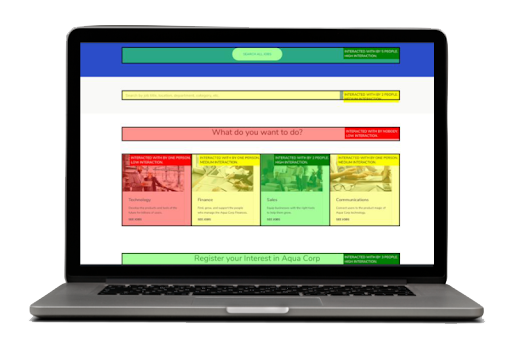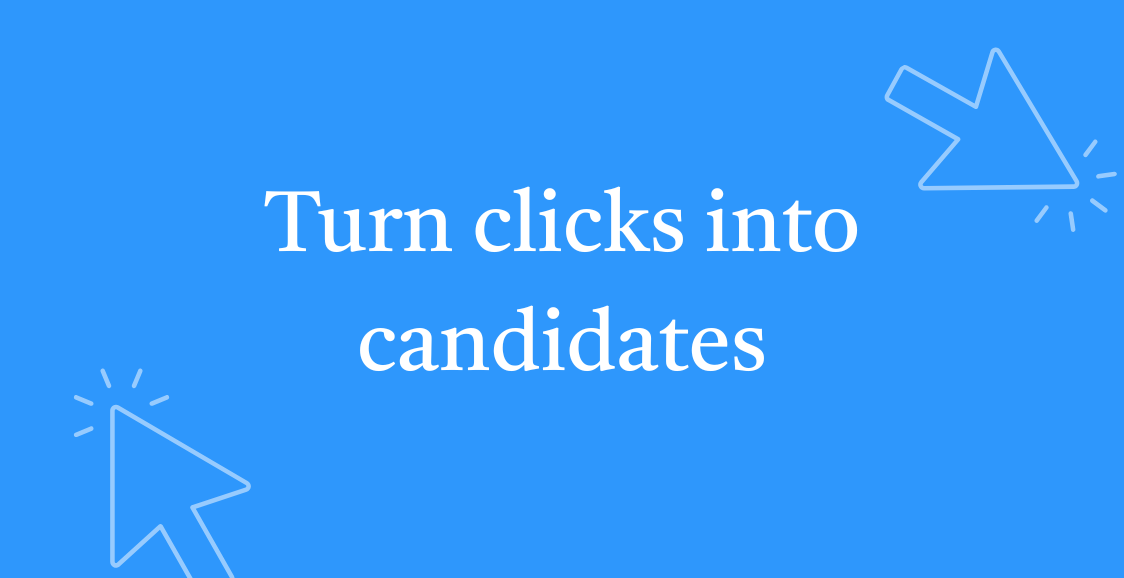Getting your career site up and running is a great first start, but the real magic happens when you start measuring what’s working and fine tuning it for impact. With the right insights, your site becomes more than a brand touchpoint. It becomes a high-performing hiring engine that attracts, converts, and connects the right people to your business.
So how do you know if your career site is doing its job? And how do you make it even better? Let’s break it down.
See what content is clicking with candidates
Your career site should help people quickly decide: Is this the right place for me? It needs to offer the right information, without making people dig for it. That’s why content matters. The words you use, the stories you tell, and even where and how content is placed on the page all play a role in how candidates engage.
To uncover what’s resonating, it’s important to track key engagement metrics. Look at page views, time spent on page, bounce rates, and click-through rates. These give you an overall view of what pages are holding attention and which may be falling flat. If candidates are dropping off quickly from certain pages, it could point to confusing layout, irrelevant content, or slow load times.
To take this further, analytics like PageUp Clinch heatmap technology gives you a way to visually track engagement. You can see where candidates are hovering, clicking, and scrolling, what’s catching attention, and what’s being ignored. Content that performs well is highlighted in green, while low-performing areas show up in red.

Example of PageUp Clinch heat mapping technology
With these insights, you can double down on what’s working, like an employee story that’s driving clicks, and rework or remove what’s not. Over time, this helps you shape a content strategy that’s genuinely candidate first and built to convert.
Measure what matters most: conversions
What does success look like for your career site? It’s not the same for every organisationorganization. You might be aiming to increase completed applications, build a stronger talent community or grow a pipeline for hard-to-fill roles.
Whatever the goal, conversion tracking plays a key role in getting you there. For example, if your goal is more applications, track how many visitors move to apply. If your numbers are low, it could be a sign that your content isn’t resonating, it’s difficult to search for jobs or that the application process is acting as a barrier.
If your focus is building your talent pool, look at how many visitors sign up for alerts, join your talent community, or complete a data capture form. These actions show intent. They signal a candidate’s willingness to stay connected, and with the right follow-up, they can become future hires.
Low conversions? Ask yourself:
Are we reaching the right people? Is the message clear and action-oriented? Are forms too long or confusing? Are we offering something of real value in return?
It’s often small details that make the biggest difference.
Attract more of the right talent
In a tight talent market, quality always wins over quantity. It’s not about how many people visit your site – it’s about how many of the right people take the next step. There are two smart ways to track this:
- Visitor-to-hire ratio – how many career site visits does it take to make a hire?
- Qualified application rate – how many completed applications meet your criteria and have been added to your talent pool?
These metrics give you a read on how effective your content and targeting are. If you’re attracting volume but not quality, it may be time to rethink your messaging, imagery, or value proposition.
Not reach the right talent? Consider the following:
- Building targeted landing pages for specific roles, functions, or locations
- Sharing authentic employee stories to give real insight into life in the team
- Use plain language to speak to what matters most to your ideal candidate
OptimiseOptimize job ads to increase engagement
Timing is everything. Knowing when your audience is most active can help you get your jobs seen by the right people at the right time.
PageUp Clinch job analytics show peak engagement times based on when candidates are viewing and starting applications. This is especially useful if you’re promoting roles via social media or email. You can line up campaigns with high-traffic windows to maximisemaximize impact.

Example of Clinch’s job analytics
In the above example, darker colors on the heatmap show the best-performing time blocks, while lighter colors highlight less active times. With these insight, you can:
- Schedule job ads during high-engagement windows
- Better time social content to drive traffic back to your site
- Send personalisedpersonalized campaigns when candidates are most likely to act
Over time, this data helps improve visibility, increase applications, and reduce time to hire.
Evaluate how seamless your application process is
A brilliant career site experience can be undone in seconds by a clunky, complicated application form. Today’s candidates expect things to be fast, simple, and mobile-friendly. If your process is long-winded or unclear, people won’t stick around. In fact, research shows up to 80% of candidates abandon an application if it’s too hard to complete (Glassdoor).
That’s why it’s important to track drop-off rates at each stage of the application process. If you’re seeing a big gap between people starting and completing an application, dig into the ‘why’.
Want to reduce your applicant drop off rate? Check for these common culprits:
- Too many form fields or mandatory uploads
- Poor mobile experience
- No progress bar or feedback
- Lack communication post-apply to return to complete application
At PageUp, we recommend a “low-barrier to entry” approach. Ask only for the essentials up front. You can always gather more info later in the process. Combine that with automated messaging to keep candidates in the loop, and you’ve got a smoother, more human experience from start to finish.
Encourage repeat visits to build deeper engagement
It’s not just about first impressions. A strong career site encourages people to return, and that’s a powerful sign of brand interest and intent.
New visitors help you track reach and awareness. But repeat visitors are the ones leaning in. They’re comparing roles, researching your teams, or waiting for the right opportunity to pop up. Ideally, 25% or more of your traffic should be repeat visitors.
If your repeat visitor rate is low, ask:
- Are we giving people a reason to come back?
- Is the content fresh, relevant, and personalisedpersonalized?
- Are we using automation to stay connected?

Example of PageUp Clinch’s visitor behavior analytics
With PageUp Clinch, you can automate follow-up workflows that nurture relationships over time. Send tailored job alerts, share new blog content, or prompt returning users with roles that match their interests. All of this keeps your brand front of mind and moves people closer to applying when the time is right.
A careers site in today’s employment market is non-negotiable and leveraging analytics will show how effective it is at supporting your recruitment efforts. Regularly reviewing the data and taking action to boost performance, will turn your career site into a powerful talent acquisition tool for your organisationorganization.
See how PageUp Clinch intelligent career sites can help you achieve your recruitment goals. Request your career site audit today.
Fresh insights for HR
Stay up to date with HR trends, tips and more when you sign up for our industry newsletter





